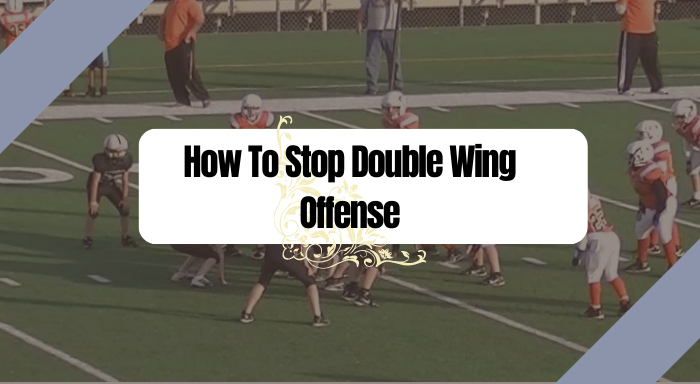How To Stop Double Wing Offense

Are you looking for ideas on defending the Double Wing offense? Well, you’ve come to the right place. This article will discuss strategies to help you stop this powerful offensive scheme.
The Double Wing offense is a personnel grouping and short-yardage package that gained popularity in the 1980s. Don Markham, the head coach of the Colton Yellow Jackets in Southern California, initially introduced it. Coach Markham, known as one of the nation’s top running backs back in his day, developed this unique offensive scheme. Interestingly enough, he coached a kid named Hemingway, who later played for the Colorado Buffalos!
The Double Wing offense typically lines up with a 2 TE Stack I formation, featuring 3 running backs, a quarterback, a center, and a student body of blockers. One of the signatures plays in this offense is the USC Power Sweep, which involves a lot of misdirection and disguises.
Over the years, coaches have been tinkering with different ideas and strategies to stop the Double Wing offense. Coach Markham continued to refine and evolve his offense throughout the 1990s. In fact, in 1997, his Gold Beach team in Oregon went undefeated and won the state championship using the Double Wing offense.
The craze for this offensive scheme spread like wildfire across schools and coaching staffs. Many teams began adopting variations of it, running it 8 to 10 times per game or even more. In fact, in 2010 and 2011, the Scio Loggers in Oregon won back-to-back state championships utilizing the Double Wing offense to perfection.
Defending against the Double Wing offense can be challenging, but it can be done with the right strategies and preparations. Throughout this article, we will delve into various techniques that have proven effective in stopping this formidable offensive scheme.
So, if you’re ready to learn how to stop against the Double Wing offense, keep reading! We’ll provide you with all the necessary knowledge and insights to ensure you don’t miss details. Let’s dive in!
The First Thing You Must Do is Stop the Double Wing Offense
The first thing you must do when defending against the Double Wing offense is to have the right mindset. This offensive scheme can be incredibly powerful and challenging to stop, so it’s crucial to approach it with confidence and determination.
Execution and assignments are key when facing the Double Wing offense. Each player on your defense needs to know their role and execute their assignments flawlessly. Everyone must be on the same page, whether it’s filling gaps, setting the edge, or pursuing the ball carrier.
One effective strategy is to utilize Empty Formations. By spreading out your defensive linemen and creating space between them, you can disrupt the Double Wing offense’s ability to create piles and walls of bodies. This forces their running backs to find openings in the front defense rather than behind a wall of linemen.
Another important aspect of defending against the Double Wing offense is stemming. This involves moving your defensive linemen just before the snap to create confusion and disrupt the offense’s timing. By changing their alignment and angles, you can throw off the Double Wing offense’s blocking assignments and create opportunities for tackles for loss or negative plays.
When defending the running game, having a strong front defense is crucial. That means having disciplined defensive linemen who can hold their gaps and not get pushed back by the offensive line. By maintaining control of the line of scrimmage, you can limit the Double Wing offense’s ability to establish a dominant running game.
Regarding pass defense, it’s important to have a solid secondary that can cover the receivers and disrupt the Double Wing offense’s passing game timing. Includes having a free safety who can provide help over the top and prevent big plays downfield.
When defending against the Double Wing offense, it’s also important to be aware of the footwork and splits of the offensive linemen. These can give clues about their blocking assignments and where the play might go. By studying these details, you can anticipate their movements and make plays accordingly.
Belief in your defensive system and trust in your teammates are crucial when facing any challenging offense, including the Double Wing. It’s important to have confidence in your game plan and execute it with full effort.
Coaching Points
Regarding coaching points for defending against the Double Wing offense, there are a few key areas to focus on. Let’s dive into these coaching points and discuss how they can help your defense stop this formidable offensive scheme.
Tackling
Tackling is fundamental in any defensive game plan, but it becomes even more important when facing a powerful offense like the Double Wing. Encourage your players to tackle low and wrap up the ball carrier’s legs. Aim for the knee cap area, just like a wrestler would do. It helps take away their power and brings them down quickly.
Bear front defense
The Bear front involves alignment with three defensive linemen in a tight formation over the center and the offensive linemen. Creates a strong presence in the middle of the line and makes it difficult for the Double Wing offense to establish running lanes. Defensive linemen should focus on getting off their blocks quickly and maintaining leverage to disrupt the offensive line’s blocking schemes.
linebackers
Your inside linebackers (ILBs) play a crucial role in defending against the power-running game of the Double Wing offense. The Sam and Mike ILBs should read the flow of the play and fill their assigned gaps with authority. They must be disciplined in their assignments and not get caught peeking into the backfield, as this can lead to big plays for the offense.
The backside defensive end is also a key player in defending against the double-wing offense. Known as the Stud End, this player is responsible for setting the edge and preventing any cutback lanes for the running back. They must maintain leverage on their block and force everything back inside towards their teammates.
In Terms Of Pass Defense
Your outside linebackers (OLBs) will cover receivers or tight ends that release into pass routes. They must maintain proper leverage and remove any easy throws for the quarterback. The OLBs should also be prepared to blitz and disrupt the timing of the passing game.
Moving to the secondary
Your cornerbacks play a critical role in defending against the Double Wing offense. They must take proper steps and maintain good technique in coverage, especially when facing stack formations or multiple receivers to one side. Their goal is to stay in position and prevent big plays downfield.
Spacing and Route Recognition
Your defenders need to understand the offensive formation and recognize potential route combinations. Allows them to anticipate and make plays on the ball. Proper spacing between defenders ensures that they can cover their assigned areas effectively and communicate with each other to prevent any breakdowns in the coverage. Field.
Extra Coaching Points
Now, let’s dive into some extra coaching points to help you prepare to defend against the Double Wing offense. These ideas will give you more tools in your defensive arsenal and ensure you’re ready for whatever the offense throws at you.
- First, let’s talk about the defensive linemen. They play a crucial role in stopping the Double Wing offense by creating piles at the line of scrimmage (LOS) and disrupting the offensive blocking schemes. Ensure your linemen understand their responsibilities and know how to get off their blocks quickly. Encourage them not to peek into the backfield, as this can leave them vulnerable to misdirection plays.
- When facing a condensed Double Wing offense, be prepared for power runs off tackle. The defensive linemen should focus on maintaining their gap integrity and not getting washed down by the offensive linemen. They should stay low and use proper technique to shed blocks and make plays on the ball carrier.
- To prevent cutback lanes, the backside defensive end must maintain leverage on their block and be disciplined in their pursuit angles. They should squeeze the ball carrier towards the inside of the field, where help from teammates is more likely to be present.
- To effectively defend against the Double Wing offense, your defenders must be great tacklers. Emphasize the basics of tackling, such as wrapping up and driving through the ball carrier. It will help prevent yards after contact and limit big plays for the offense.
- Coaching points for defending against blocking schemes in the Double Wing offense include teaching your defenders the basics of base and reach blocks. They should understand how to take on these blocks and maintain their position to disrupt the flow of the offense. Encourage them to stay low, use their hands effectively, and keep their feet moving to avoid getting overwhelmed by the offensive line.
Other Defensive Looks to Give the Double Wing Offense
Let me tell you a story that sums it all up. It was the 2010 State title game, and our team faced off against a BAD Double Wing offense. Our opponents, the Scio Loggers, were known for their powerful running game and had steamrolled through the season. But we weren’t going to let that intimidate us.
- In the lead-up to the game, our coaches devised a game plan that included different defensive looks to defend against the Double Wing offense. We knew we couldn’t just stick with one approach and expect it to work against a formidable opponent.
- So, we lined up in various defensive formations on game day and gave them different looks. One play, we would come out in a 5 -2 Bear front, with five down linemen and two linebackers. This allowed us to clog up the interior gaps and prevent their running backs from finding open lanes.
- We switched it up in another play and went with a 4-3 Hawkeye front, shifting our defensive line to one side. Created confusion for the offense and disrupted their blocking assignments.
- We even threw in a 3-4 Bear Indian Slant, where we brought pressure from different angles and forced their quarterback to make quick decisions under duress.
- Throughout the game, our defenders executed the game plan flawlessly. They maintained discipline, read their keys, and reacted quickly to shut down any potential running lanes. Our tackling was on point as we wrapped up their ball carriers and prevented big gains.
- After the game, our parents and coaches congratulated us on a job well done. Our defensive strategy had successfully defended against one of the best double-wing offenses in the state.
- The key takeaway from this story is that defending against the Double Wing offense requires creativity and adaptability. By giving different defensive looks and mixing up formations, we kept the offense guessing and disrupted their rhythm. It’s important to study your opponent, identify their tendencies, and devise a game plan that exploits their weaknesses.
- So, don’t be afraid to experiment with different defensive looks when facing a team running the Double Wing offense. Stay disciplined, communicate with your teammates, and trust in your preparation. With the right approach and execution, you can effectively defend against the Double Wing offense and come out on top.
Conclusion
Defending against the Double Wing offense can be daunting, but with the right game plan and execution, it is possible to shut down this powerful running attack. By studying film, recognizing offensive tendencies, and communicating with your teammates, you can anticipate where the ball is going and make timely decisions to disrupt their rhythm. Be creative and adaptable by giving different defensive looks and mixing up formations. Remember to stay disciplined, trust your preparation, and execute your game plan flawlessly.
So, next time you face off against a team running the Double Wing offense, don’t panic! Embrace the challenge and approach it with confidence. Stay focused on your assignments, communicate effectively with your teammates, and be ready to adapt on the fly. You can effectively defend against the Double Wing offense and potentially emerge victorious by doing so. Remember, it’s not about your opponent’s size or reputation but your preparation and execution on the field that will ultimately lead to success.






